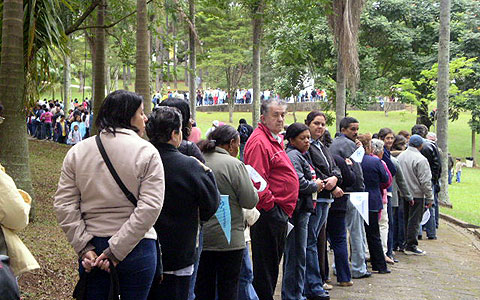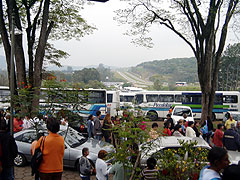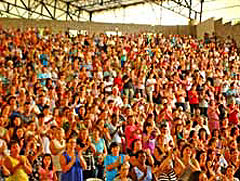On the way to the Covenant centenary
The large pilgrimages to Atibaia, Brazil have begun
 |
Atibaia, Brasil: O essencial para as pessoas é conseguir entra no Santuário... Atibaia, Brasil: Lo esencial para los peregrinos es entrar al Santuario...
Atibaia, Brasilien: Das Wichtigste ist, ins Heiligtum zu gehen… |
 |
|
Llegada de los buses The busses arriving... Ankunft der Busse... |
|
 |
|
Alegría pura The joy to be in the house of the Mother Wie freute ich mich, als man mir sagte: Wir ziehen zum Haus… der Gottesmutter, zum Haus des Herrn Fotos: Ir. M. Nilza © 2009 |
|
BRAZIL, Sr. M. Nilza/mkf. The large pilgrimages to Atibaia, Brazil have begun. The dioceses have started to arrive on pilgrimage with their bishops. Every Sunday, thousands of pilgrims arrive by bus to visit our Mother and Queen in her shrine.
In a Skype conversation on 15 March, Sr. M. Nilza, who responsible for the Pilgrim Mother web page (www.maeperegrina.com.br) and is currently in Atibaia, spoke about the pilgrimages, what brings pilgrims to the shrine and a song which could be sung far beyond Brazil…
Sr. M. Nilza, how many pilgrims come to the shrine?
Last week, more than 80 buses with pilgrims from Santo Amaro arrived, now we have groups from Jundiaí, whose bishop has used this as an opportunity to say goodbye because he will now become archbishop for Juiz da Fora. They arrived with more than 100 buses, not to mention the hundreds of cars and minibuses which will also arrive.
Next week, pilgrimages from Santo André and Campo Limpo will be arriving together with their bishops. The group from Campo Grande organized a day’s leave for their drivers because one comes to the shrine on pilgrimage. They confirmed that more than 200 buses will arrive.
But how can such a small shrine receive so many pilgrims?
You would need to spend some time here with us to experience the shrine bursting at the seams with beloved children, their eyes turned towards the MTA and an enormous queue outside as people wait their turn to enter. Groups of volunteers work shifts to help welcome the pilgrims. But when the dioceses come, they give us enough warning and a good many of these pilgrims come here to work.
This is so beautiful. They arrive early to welcome their own people. When people go on pilgrimage they don’t expect great comforts – they only want what is necessary. It would be a good experience team preparing for 2014 could come here and see how all this works.
Our pavilion holds 8,000 people but on days when these large pilgrimages arrive, the same number of people inside the pavilion can also be found on the outside, listening, responding and singing happily. After all, this is Mother’s house. The attitude of all the pilgrims is: "We are family and we have come home to our Mother."
How is all this organised? Aren’t there complaints if people don’t find space and have to wait in line for hours?
Sacrifices are made. For us sisters and lay people who receive the pilgrims, we would like each pilgrim to have everything they need. But we are so many children and the MTA is pleased with us. Whatever goes wrong is offered to her as a gift of love because she gives us so much.
It will be the same in 2014. People don’t want a 5-star hotel. They want to arrive and be welcomed with love; they want a personal encounter with the MTA in the shrine. Beyond this, everything else can be very simple.
Every year, we produce a prayer booklet that accompanies the pilgrimage programme. These are produced annually so that they reflect the signs of the times and the Movement’s motto for the year.
People arrive and buy these booklets so they can follow the entire program and they then take them home so that they can pray with it for the rest of the year.
Meals are left to individual preference. Some bring their own food and have a picnic. They lay blankets on the grass around the shrine and the family sits on the grass to eat. Others prefer to buy sandwiches or lunch and this is also possible. They order their food when they arrive and at mealtimes they collect their food from various distribution points.
There are thousands of people and they know that there aren’t enough tables for everyone. There are a good many tables spread around the grounds and these operate on a first come-first serve basis. Those who can’t find tables sit in the shade under the trees and eat their meal happily. Nobody complains because they can’t find a table. They are on pilgrimage and this is part of it.
What do the pilgrims expect and what are their concerns?
What is important for them is to enter the shrine. When, for example, we have 10,000 people – and this is not so unusual – they wait in line for more than two hours. Once they are in the shrine, they can’t stay too long because there are many people still waiting outside.
The benches in the shrine are removed so that there is more space. Only one bench is left in the shrine for the elderly. Nobody pushes anyone else. It is incredible. People are in Mother’s house. They feel that they can’t stay longer and so they lay down their letters, flowers and messages from those who remained behind at home and they leave the shrine. Those who want to stay a bit longer return later, during lunch or during a part of the programme when there are less people.
But don’t they participate in the programme? No, some of them sacrifice a part of the programme. But isn’t this serious? Not at all! What is important is that they have a personal encounter with the MTA in the shrine.
How are the pilgrims received?
The personal touch is that when the buses arrive at the gate, the pilgrims are personally welcomed by a volunteer. The volunteer climbs on the bus with joy and says that the MTA is happy that they have arrived, gives a short message and the prepares the pilgrims by telling them that today is a day of celebration at Mother’s house and that thousands of other brothers will also be arriving and requests that each person collaborate so that the Blessed Mother can be attentive to everyone.
This provides the group with a personal touch because they are welcomed individually and from that moment they enter with an open heart. Here people form really enormous queues so that they can say hello to the MTA.
What do you do when it rains? Or when food for so many people runs out?
The pilgrims don’t give up. They pull out their umbrellas and although they may be soaked, they remain firm and content. When people are motivated, they can face anything. What is important is that they are well-received. The sisters and volunteers have a rule here: We can run out of everything – water, food, anything. Only one thing cannot be lacking: a smile and a great deal of love for the pilgrims. People want to be treated like human beings and with courtesy. They all understand that when there are 10,000 people, it is possible that we will run out of water by the end of the day.
They are understanding because during they felt welcome throughout the day. They received what they needed and if something runs out, it’s because of the sheer number of people.
There are also volunteers around the shrine. What do they do? They make sure that there is silence so that people can pray. Often they are not needed because people fall silent when the feel the holiness of the place.
What else is important for the pilgrims to ensure that they have a moving experience?
Confession is also important. People enter the shrine and their hearts are changed. We must have priests to hear confession. People leave the shrine and ask for this. There are so many conversions – the priests never stop being amazed by this. There are people who have not been to confession in 40 years but they feel so personally welcomed here in the shrine that work up the courage to confess.
Pilgrims also come looking for a place to pray in front of the Eucharistic Jesus. Since the to-and-fro of people entering the shrine never stops, adoration is held at the chapel in the province house. There are signs calling for silence and many people go in and spend some time with Jesus in front of the Blessed Sacrament.
What is the programme for these large pilgrimages?
The buses are welcomed at the entrance to the shrine from eight o’clock in the morning. At nine, the whole group is welcomed at the entrance to the centre where there is a large cross. If it is a diocese, they normally bring the auxiliary Pilgrim Mother and a picture of the patron saints at their respective parishes as well as the flags for their towns.
Sister gives a short introduction about the visit to the shrine; she welcomes the pilgrims and speaks of the pilgrimage graces. Everyone then goes to the shrine. Although they can’t all go in, they all greet the Blessed Mother to say they have arrived and they pray the consecration prayer. At the shrine, they also remember that we are heading together towards 2014.
From there, they go to the Fr. Kentenich monument where Sister speaks about our Father and Founder. Here, they pray Father’s novena and go down to the pavilion. The youth and children are separated because they will have their own programme, prepared by the volunteers.
Each group listens to a more personal talk. The groups meet again at 11.30 at the pavilion where they receive the blessing of the Blessed Sacrament. Lunch is at twelve and at 13.30 everyone participates in a Marian moment or the Stations of the Cross, depending on the liturgical season. This is followed by the closing Mass at 14.30. See how everything is so simple but everyone goes home content.
When the bishop accompanies the group, the Mass time is organised around his schedule. For example, Mass can be held during the morning and in the afternoon, the pilgrims receive the blessing of the Blessed Sacrament.
What is this song the pilgrims sing with such enthusiasm? Is it about the Covenant of Love?
The pilgrims enthusiastically sing: "On our way to the Covenant centenary/this is our flag/open your heart to this grace/so that together we may bear fruit for the Church." Everyone sings and waves little Schoenstatt flags - on fire for 2014.
We wrote this song and it has become popular among the pilgrims. It is also often sung in the parishes. The bishops and priests don’t need to know that we are preparing for 2014! Our people are very excited about the centenary. This is what we talk about every 18th, but we are working on this. We are preparing annual novenas. We have already been preparing the centenary for four years. There is no longer anyone who belongs to the Movement or receives the Pilgrim Mother who doesn’t know that we’ll have a huge celebration in 2014!
Many people are saving to go to Schoenstatt. Their dream is to be in the Mother Shrine on 18 October 2014. If the people there don’t do anything on that day, Schoenstatt will still be crowded with people. With or without a programme, our Schoenstatt people will celebrate 100 years of the Movement’s founding.
On the 18th of every month, they have a Covenant Mass and this song can be heard and slowly, even the bishops are learning it!
Quite simply, our people love our Mother and Queen. Last week, I received an email from a priest who is writing the history of his diocese, São João da Boa Vista, Sao Paulo, and he wanted to know the date on which the Blessed Mother first arrived in his diocese because the Pilgrim Mother Campaign was a turning point in the history of the diocese.
What will it be like on 18 October 2014 when these pilgrims from Brazil, who are already so excited about the centenary, arrive?
Imagine the Mother Shrine bursting with people, with bright-eyed sons and daughters because they came to visit the MTA in Schoenstatt.
When our pilgrims were there last year, they left here with a joyful heart because they were going to their original home. When they arrived, it was already late and the Mother Shrine was closed. Even so, they wanted to go on pilgrimage there.
They prayed at the door, kissed the walls and door handle and said, "Mother, we here outside. We waited so long to visit you." When they told me this, my heart skipped a beat. The Mother Shrine belongs to all of them and it is a dream to be able to go there one day. Schoenstatt has changed the lives of thousands of people.
Translation: Sarah-Leah Pimentel, Johannesburg, South Africa